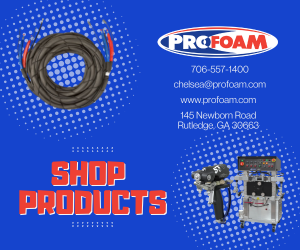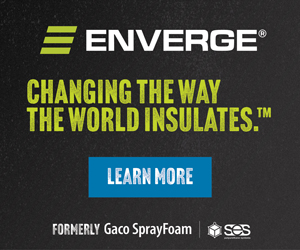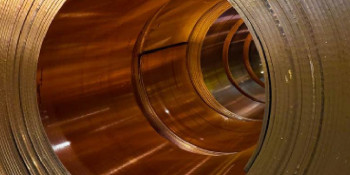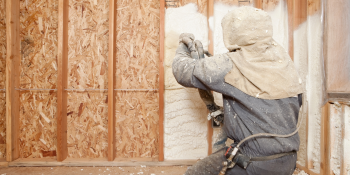Q&A Forums
540 Issue Post New Topic | Post Reply
| Author | Comments |
|---|---|
|
Posted: May 30, 2010 05:34 PM
|
540 Issue
Sprayed 10,000 sq. ft roof this past week with no issues. Changed to a new set to work on some vertical walls and immediately starting having issues.Spraying with an 01 Chamber, 2500 psi, played with temps all the way from 160 to 135 across the board. First pass (10 mils) sets fine. However, if you start to build up on seams , product immediately starts to blister. All pressures are fine, polyurea not off ratio at all, but big time problems with pinholes and blistering once we build up any sort of thickness. I don't understand why we are having no issues at all at 10-15 mils, but if we try to build up in any areas what so ever, we immediately see the blistering and pinholing. Suggestions??? Let me say again, not off ratio. |
|
Posted: May 30, 2010 06:15 PM
|
www.polyurea.com... |
|
Posted: May 30, 2010 07:46 PM
|
Yeah, but you guys are the ones spraying the VFI 540. The guys on www.polyurea.com are spraying arromatics and aliphatics. Our guys on this board have more experience with VFI's 540 I used foam for flashing if that counts dude :) |
|
Posted: May 31, 2010 07:24 AM
|
I had this issue when the relative humidity was very high and spraying poleurea. Just a thought. Could you help me locate any info about what and how to spray tar and gravel roofs in our Canadian temperatures, someone I know is going to re tar and gravel a 30,000 sq. ft. roof and I would like to give him a price from our industry but he is very skeptical. +Good luck with your pin hole issue. |
|
Posted: May 31, 2010 08:55 AM
|
dennis is gettin warm here,, usually pinholein is a component of moisture contamination...i think,, steve,,i rarely get off the ground,,roofs make me dizzy(er),,, |
|
Wade LeCompte
Posted: May 31, 2010 11:13 AM
|
"Changed to a new set" really jumping out at me here??? |
|
Dennis Davidson
Posted: Jun 03, 2010 11:03 AM
|
Hello Steve Haven't had much time to respond lately. 540 is a hybrid poly and as such reacts like a conventional urethane that drys fast. In other words, you can't build it up like a pure poly. If you spray it over about 15 mils, you end up with solvent entrapment - "blisters". Pinholes are another matter. Moisture/humidity is only one possible cause. Other causes are spraying material to hot. Try turning you temps lower, remember this is not a pure poly. Spraying to close to the surface or not mixing the color side enough also causes problems. This could explain why you had issues with a new set. If it's not mixed long enough to move the solids from the bottom you get a bad mix, even though the pump ratio is correct. This usually shows up as a color variance on the surface. Also, contrary to popular belief, Aluminum pigmented coatings "in general" do not weather very well. They will chalk and wear away faster than other coatings. Hope this helps |
|
Posted: Jun 03, 2010 11:59 AM
|
Probably should have called you right off the bat Dennis. Can I let the product sit for a little while, then come back and re-apply? You know now that you mentioned it, the last time we seamed in new metal on a vertical wall, we used an aliphatic for a processing plant application and price wasn't an issue. This would explain why we are seing blistering so quickly when we build up the material to fill in the seams using the 540. Steve |
|
Dennis Davidson
Posted: Jun 03, 2010 03:29 PM
|
You don't want to let any urethane coating set for more than a few days before applying the top coat. You can coat the seams with 540 then coat the field of the roof after about 30 mins. Every roof I've seen that had 540 or 550 installed on it had pinholes and some were really bad! Basically the 540 was developed to allow a double coat the same day but not as a high build product for a single coat like a pure poly. With a pure poly you can spray 250 mils or more all day long. The cure time for 540 is 3-15 mins. so 30 mins is a safe time between layers. Just looked at the product data on 540 and it states: "The ultra violet protection in 540 aluminum coating is aluminum paste. The aluminum paste settles to the bottom of the drum during shipment and storage. Therefore, the "A" side (iso) drum has to be thoroughly mixed before spraying; otherwise the aluminum paste will be left on the drum bottom. Product sprayed with aluminum paste still on the bottom of the drum will not preform as designed and the coating will not last as long. The coating will appear streaky if all drums are not mixed properly." Wow, talk about an escape clause! If the drums have been setting for more than a couple months it's impossible to get all the "paste" off the bottom. So if there's a problem then it's your fault for not mixing it properly. You can't open the drums to scrape the bottoms and the mixer doesn't reach the bottom either. Solution - always ask for "fresh material" when ordering!!! In the past I've received materials that were well over a year old. |
|
SprayFoamSupply.com
Posted: Jun 04, 2010 09:06 AM
|
Steve, Didn't you say in another post that you were not running an air dryer? Are you using a fusion gun? Maybe you have trace amounts of moisture in the clean off air. George |
|
Posted: Jun 04, 2010 09:09 AM
|
Yes and No! I went from an E-20 in November to a Gama 250. Increased the size of our air compressor from 15 CFM to 25 CFM, but kept the same dryer that was for a smaller compressor that was only designed for 10 cfm. Installed an Ingersoll Rand 25 cfm dryer yesterday and hopefully that solves the problem. My point about the water seperator in an earlier post was that you are better off having something than nothing at all. Raining today, so I can't wait to spray. Dennis is probably right, The last time we seamed r panels to a metal building, I was using VFI 277 Aliphatic and we never had any issues with thickness. The only times that I have ever used 540 was for metal or foam on a roof. I may be trying to do to much with the material though and the smaller air dryer was probably not enough to keep up with our humidity right now causing moisture to build up. Hopefully that will eliminate the problem along with 10 mil passes on the 540. If not, I will use Versaflex's 380 to finish off the metal seaming and see if that works any better. |
|
Posted: Jun 05, 2010 08:01 AM
|
Thank you for the vote of confidence Boy, but I think you are referring to Macs about the thickness issue. I am usually not ever right!! Dennis |
|
Posted: Jun 05, 2010 01:02 PM
|
LOL...I have full confidence in you as well, but I was talking about the other Dennis=Macs |
|
Gerry Wagoner
Posted: Jun 28, 2010 10:08 AM
|
There should be no problem with spraying VFI 540 at 100-200 mils thick. We have done it many times, and customarily spray 40-50 mils in one pass. I am afraid if you blame the blisters on product thickness you will go down the wrong diagnostic road and not isolate the real problem. Moisture is the likely culprit, with mixing being a distant second. Lastly, one of the beauties of polyurea (hybrid or otherwise) is spraying full thickness in one pass. Call Rich Bradley at 314-422-2240. `oG |
|
Posted: Jun 28, 2010 10:05 PM
|
We have never had problems like this before. 1st of 2 sets went fine. Second set after mixing for an hour siezed everything up from the stick pump on. I thought the same thing, moisture then mixing. Notta on either. I'll take the blame, but we definately received more than our share of aluminum oxide in this one set. I have never had a stick pump seize up once much less a half of dozen times in one day due to aluminum oxide. Oh well, on to the next set! PS We are not new to 540 by any means! |
|
Dan Beecher
Posted: Jun 29, 2010 08:40 PM
|
I've sprayed a lot of 540, that sounds really unusual. Did you retain any samples you can have VFI test? I was gonna say moisture too, but if it seized up your pump sounds like a QC prob on their end. Compare that sample to another drum see if they look the same. Just my 2 cents. |
|
Posted: Jun 29, 2010 10:35 PM
|
3/4 of a set. I used a set of versaflex 380 to finish up the job. Since then, I have sprayed 6 sets of foam and I am still finding aluminum oxide in the lines and block. Since this incident, I am beginning to re-think using one machine for both polyurea and foam. It takes two long to work this problem through the system. This is a first for me. I love the product and will use again. I will probably screen the remainder of the set out before trying to use again, but there is no doubt in my mind that we got the bottom of a batch that wasn't mixed properly. Keep in mind that the first set went off without a hitch. As soon as we switched to the second set is when we begin to have problems. It wasn't until we cleaned out everything and switched over to the versaflex did the problems begin to work themselves out. |





























